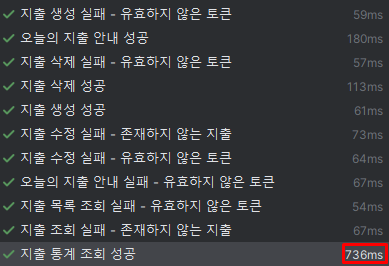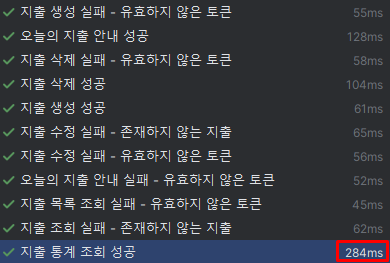Spring Boot 에서 Hibernate 6 와 MySQL 8 사용 시 GenerationType.SEQUENCE 설정 방법
Intro
테스트 중에 상대적으로 소요시간이 오래 걸리는 테스트가 있습니다.
통계 정보가 잘 나오는지 테스트 하다보니, 테스트용 과거 데이터를 INSERT하는데 시간이 많이 걸려서 테스트 시간을 줄이고, 덤으로 운영 시에도 데이터베이스 서버와 통신 횟수를 줄이기 위해 Generation Type을 IDENTITY에서 SEQUENCE로 변경하여 관련 내용을 공유합니다.
Generation Type IDENTITY의 문제
MySQL에서는 Sequence Table이 생성되지 않다보니 Generation Type을 IDENTITY로 설정해왔습니다. 그런데, IDENTITY에서는 INSERT 작업을 Batch 처리할 수 없는 문제가 있습니다.
공식 문서(링크)에서는 아래와 같이 언급하고 있습니다.
If the underlying database supports sequences, you should always use them for your Hibernate entity identifiers.
Only if the relational database does not support sequences (e.g. MySQL 5.7), you should use the
IDENTITYgenerators. However, you should keep in mind that theIDENTITYgenerators disables JDBC batching forINSERTstatements.
Hibernate 검색하면 자주 보이는 Vlad Mihalcea 님의 블로그 글(링크)에 따르면, entity가 저장됐을 때는 반드시 실행 중인 Persistence Context에 연결해야 하는데, Persistence Context는 entity의 Map 역할을 하고, 이 Map의 key는 entity type과 entity identifier로 구성됩니다. 이는 repository에서 상속받을 때 볼 수 있습니다.
1
public interface BudgetPlanRepository extends JpaRepository<BudgetPlan, Long>
그런데 Generation Type을 IDENTITY로 설정한 경우 entity의 id 값을 INSERT 후에야 알 수 있기 때문에 persist method가 호출되면 바로 INSERT 문이 실행됩니다.
아래는 원문입니다.
Whenever an entity is persisted, Hibernate must attach it to the currently running Persistence Context which acts as a
Mapof entities. TheMapkey is formed of the entity type (its JavaClass) and the entity identifier.For
IDENTITYcolumns, the only way to know the identifier value is to execute the SQL INSERT. Hence, the INSERT is executed when thepersistmethod is called and cannot be disabled until flush time.For this reason, Hibernate disables JDBC batch inserts for entities using the
IDENTITYgenerator strategy.
처음에는 IDENTITY 로 설정한 상태에서 문제를 해결해보려고 했습니다. 최근 올라온 Vlad Mihalcea 님의 블로그 글(링크)을 포함해서 구글링해서 나오는 글들을 참고했는데, IDENTITY 고수하기 위해 개인적으로는 과해 보이는 작업을 해야한다거나 결국엔 SEQUENCE나 JdbcTemplate을 이용하는 방식이었습니다.
그래서 공식 문서에서도 추천하는대로 Generation Type을 SEQUENCE로 변경하였습니다. Hibernate 6 부터는 각 entity 마다 sequence table을 별도로 만들어주어야 하는 문제가 있기는 하지만, 방향을 틀어서 INSERT 작업을 Batch 처리할 때 마다 entity 별로 JdbcTemplate을 사용해야한다면 애초에 JPA를 사용하지 않는게 맞다고 생각되어 Generation Type을 SEQUENCE로 변경하였습니다.
물론 테스트에서만 Batch 작업을 한다면 JdbcTemplate 도 괜찮은 선택이라 생각됩니다.
설정 작업
Spring 설정
JPA 설정만 살펴보겠습니다.
hbm2ddl과 batch_size는 필수고, 이외에는 아시겠지만 자신의 프로젝트에 맞게 선택 사항입니다.
1
2
3
4
5
6
7
8
9
10
11
12
spring:
jpa:
hibernate:
ddl-auto: validate
show-sql: true
properties:
hibernate:
format_sql: true
hbm2ddl:
auto: create
jdbc:
batch_size: 100
Batch Size
spring.jpa.properties.jdbc.batch_size는 100으로 설정했는데, batch size를 결정하는 구체적인 요소를 파악하지 못했습니다.
다른 분의 블로그 글(링크)을 보면 DBA 요청에 의해서 설정하는 경우도 있고, 우아한 기술블로그(링크)에 있는 글을 보면 MySQL에는 서버로 전송할 수 있는 최대 허용 패킷 크기인 max_allowed_packet이 있어 이를 고려해서 설정해야겠습니다.
max_allowed_packet의 기본값은 67108864 bytes고, 최대값은 1073741824 bytes 입니다.
hbm2ddl
임시로 sequence table을 자동 생성하기 위해 spring.jpa.properties.hbm2ddl.auto 를 create로 설정했습니다.
공식문서(링크)에도 나왔듯 update 옵션은 production 환경에서는 적합하지 않아 쓰지 말라고하니 update로 설정한다면 주의해야겠습니다.
Although Hibernate provides the
updateoption for thehibernate.hbm2ddl.autoconfiguration property, this feature is not suitable for a production environment.
문서에서 FlyWay나 Liquibase 같은 migration 도구 사용을 강추하고 있고 사용도하고 있는데, 저는 일단 테스트를 위해 hbm2ddl.auto를 설정합니다.
You should always use an automatic schema migration tool and have all the migration scripts stored in the Version Control System.
Entity 설정
Entity에서 Generation Type을 SEQUENCE로 변경해줍니다.
1
2
3
@Id
@GeneratedValue(strategy = GenerationType.SEQUENCE)
private Long id;
그리고 실행시켜보면, 아래와 같이 entity 별로 _seq 가 post fix 로 붙은 Sequence Table이 생성된 것을 볼 수 있습니다. 내부에는 BIGINT type의 next_val 이라는 하나의 컬럼만 존재합니다.
MySQL Connector/j 설정
1개의 Query로 만들어주는 것은 MySQL Connector/j 이기 때문에 설정이 필요합니다.
아래는 JDBC 경로를 Testcontainer 용으로 설정한 것이긴 한데, rewriteBatchedStatements=true 부터 보시면 됩니다.
jdbc:tc:mysql:8.0.35:///?user=root?password=test?rewriteBatchedStatements=true&profileSQL=true&logger=Slf4JLogger&maxQuerySizeToLog=99999
rewriteBatchedStatements=true는 반드시 설정해주어야 Batch 처리가 됩니다. true로 설정해야INSERT나UPDATE시에 개별 Query가 아닌 1개의 Query로 합쳐서 요청합니다.profileSQL=true는 실제로 전송되는 SQL을 출력합니다.logger=Slf4JLogger는 log를 출력할 logger를 설정합니다.maxQuerySizeToLog=99999는 log에 출력할 Query의 최대 길이를 설정합니다. 기본 값은 2048 입니다.
설정에 자세한 설명은 MySQL 매뉴얼(링크)을 통해 확인하실 수 있습니다.
실행
이제 INSERT 작업을 Batch 처리하여 테스트를 다시 실행해봅니다. 코드에서는 saveAll() 메서드를 호출합니다.
주요 타겟이었던 테스트의 소요 시간이 736ms 에서 284ms 로 줄었습니다. 오차 감안하면 대략 400ms 감소, 50% 넘게 줄었습니다. 그리고 log를 보면 hibernate 는 각 INSERT 마다 Query를 출력하지만, MySQL Connector의 log를 보면 하나의 INSERT 문으로 전송된 것을 볼 수 있습니다.
1
2
3
4
5
6
7
8
9
10
11
12
13
14
15
Hibernate:
insert
into
expenses
(amount,category_id,datetime,exclude_in_total,memo,user_id,id)
values
(?,?,?,?,?,?,?)
Hibernate:
insert
into
expenses
(amount,category_id,datetime,exclude_in_total,memo,user_id,id)
values
(?,?,?,?,?,?,?)
2023-12-02T21:01:26.793+09:00 INFO 38524 --- [ Test worker] MySQL : [QUERY] insert into expenses (amount,category_id,datetime,exclude_in_total,memo,user_id,id) values (10000,5,'2023-11-16 21:01:26.690175',null,'오늘 지출',2,136),(10000,6,'2023-11-16 ...
INSERT 문이 너무 길어서 뒤에는 생략했습니다.
그런데 INSERT 할 데이터의 갯수가 많을 때는 Sequence Table 호출이 여러번 되는 것을 볼 수 있습니다.
1
2
3
4
5
6
7
8
9
10
11
12
13
14
15
16
17
18
19
20
21
22
23
24
25
26
27
28
29
30
31
32
33
34
35
36
37
38
39
40
41
42
43
44
45
46
Hibernate:
select
next_val as id_val
from
expenses_seq for update
2023-12-02T21:01:26.695+09:00 INFO 38524 --- [ Test worker] MySQL : [QUERY] select next_val as id_val from expenses_seq for update [Created on: Sat Dec 02 21:01:26 KST 2023, duration: 1, connection-id: 10, statement-id: 0, resultset-id: 0, at com.zaxxer.hikari.pool.ProxyPreparedStatement.executeQuery(ProxyPreparedStatement.java:52)]
2023-12-02T21:01:26.695+09:00 INFO 38524 --- [ Test worker] MySQL : [FETCH] [Created on: Sat Dec 02 21:01:26 KST 2023, duration: 0, connection-id: 10, statement-id: 0, resultset-id: 0, at com.zaxxer.hikari.pool.ProxyPreparedStatement.executeQuery(ProxyPreparedStatement.java:52)]
Hibernate:
update
expenses_seq
set
next_val= ?
where
next_val=?
2023-12-02T21:01:26.697+09:00 INFO 38524 --- [ Test worker] MySQL : [QUERY] update expenses_seq set next_val= 151 where next_val=101 [Created on: Sat Dec 02 21:01:26 KST 2023, duration: 2, connection-id: 10, statement-id: 0, resultset-id: 0, at com.zaxxer.hikari.pool.ProxyPreparedStatement.executeUpdate(ProxyPreparedStatement.java:61)]
2023-12-02T21:01:26.697+09:00 INFO 38524 --- [ Test worker] MySQL : [FETCH] [Created on: Sat Dec 02 21:01:26 KST 2023, duration: 0, connection-id: 10, statement-id: 0, resultset-id: 0, at com.zaxxer.hikari.pool.ProxyPreparedStatement.executeUpdate(ProxyPreparedStatement.java:61)]
2023-12-02T21:01:26.702+09:00 INFO 38524 --- [ Test worker] MySQL : [QUERY] commit [Created on: Sat Dec 02 21:01:26 KST 2023, duration: 5, connection-id: 10, statement-id: -1, resultset-id: 0, at org.testcontainers.jdbc.ConnectionDelegate.commit(ConnectionDelegate.java:11)]
2023-12-02T21:01:26.702+09:00 INFO 38524 --- [ Test worker] MySQL : [FETCH] [Created on: Sat Dec 02 21:01:26 KST 2023, duration: 0, connection-id: 10, statement-id: -1, resultset-id: 0, at org.testcontainers.jdbc.ConnectionDelegate.commit(ConnectionDelegate.java:11)]
2023-12-02T21:01:26.703+09:00 INFO 38524 --- [ Test worker] MySQL : [QUERY] SET autocommit=1 [Created on: Sat Dec 02 21:01:26 KST 2023, duration: 1, connection-id: 10, statement-id: -1, resultset-id: 0, at org.testcontainers.jdbc.ConnectionDelegate.setAutoCommit(ConnectionDelegate.java:11)]
2023-12-02T21:01:26.703+09:00 INFO 38524 --- [ Test worker] MySQL : [FETCH] [Created on: Sat Dec 02 21:01:26 KST 2023, duration: 0, connection-id: 10, statement-id: -1, resultset-id: 0, at org.testcontainers.jdbc.ConnectionDelegate.setAutoCommit(ConnectionDelegate.java:11)]
2023-12-02T21:01:26.707+09:00 INFO 38524 --- [ Test worker] MySQL : [QUERY] SET autocommit=0 [Created on: Sat Dec 02 21:01:26 KST 2023, duration: 1, connection-id: 10, statement-id: -1, resultset-id: 0, at org.testcontainers.jdbc.ConnectionDelegate.setAutoCommit(ConnectionDelegate.java:11)]
2023-12-02T21:01:26.708+09:00 INFO 38524 --- [ Test worker] MySQL : [FETCH] [Created on: Sat Dec 02 21:01:26 KST 2023, duration: 0, connection-id: 10, statement-id: -1, resultset-id: 0, at org.testcontainers.jdbc.ConnectionDelegate.setAutoCommit(ConnectionDelegate.java:11)]
Hibernate:
select
next_val as id_val
from
expenses_seq for update
2023-12-02T21:01:26.709+09:00 INFO 38524 --- [ Test worker] MySQL : [QUERY] select next_val as id_val from expenses_seq for update [Created on: Sat Dec 02 21:01:26 KST 2023, duration: 1, connection-id: 10, statement-id: 0, resultset-id: 0, at com.zaxxer.hikari.pool.ProxyPreparedStatement.executeQuery(ProxyPreparedStatement.java:52)]
2023-12-02T21:01:26.710+09:00 INFO 38524 --- [ Test worker] MySQL : [FETCH] [Created on: Sat Dec 02 21:01:26 KST 2023, duration: 0, connection-id: 10, statement-id: 0, resultset-id: 0, at com.zaxxer.hikari.pool.ProxyPreparedStatement.executeQuery(ProxyPreparedStatement.java:52)]
Hibernate:
update
expenses_seq
set
next_val= ?
where
next_val=?
2023-12-02T21:01:26.712+09:00 INFO 38524 --- [ Test worker] MySQL : [QUERY] update expenses_seq set next_val= 201 where next_val=151 [Created on: Sat Dec 02 21:01:26 KST 2023, duration: 2, connection-id: 10, statement-id: 0, resultset-id: 0, at com.zaxxer.hikari.pool.ProxyPreparedStatement.executeUpdate(ProxyPreparedStatement.java:61)]
2023-12-02T21:01:26.712+09:00 INFO 38524 --- [ Test worker] MySQL : [FETCH] [Created on: Sat Dec 02 21:01:26 KST 2023, duration: 0, connection-id: 10, statement-id: 0, resultset-id: 0, at com.zaxxer.hikari.pool.ProxyPreparedStatement.executeUpdate(ProxyPreparedStatement.java:61)]
2023-12-02T21:01:26.718+09:00 INFO 38524 --- [ Test worker] MySQL : [QUERY] commit [Created on: Sat Dec 02 21:01:26 KST 2023, duration: 5, connection-id: 10, statement-id: -1, resultset-id: 0, at org.testcontainers.jdbc.ConnectionDelegate.commit(ConnectionDelegate.java:11)]
2023-12-02T21:01:26.718+09:00 INFO 38524 --- [ Test worker] MySQL : [FETCH] [Created on: Sat Dec 02 21:01:26 KST 2023, duration: 0, connection-id: 10, statement-id: -1, resultset-id: 0, at org.testcontainers.jdbc.ConnectionDelegate.commit(ConnectionDelegate.java:11)]
2023-12-02T21:01:26.720+09:00 INFO 38524 --- [ Test worker] MySQL : [QUERY] SET autocommit=1 [Created on: Sat Dec 02 21:01:26 KST 2023, duration: 1, connection-id: 10, statement-id: -1, resultset-id: 0, at org.testcontainers.jdbc.ConnectionDelegate.setAutoCommit(ConnectionDelegate.java:11)]
2023-12-02T21:01:26.720+09:00 INFO 38524 --- [ Test worker] MySQL : [FETCH] [Created on: Sat Dec 02 21:01:26 KST 2023, duration: 0, connection-id: 10, statement-id: -1, resultset-id: 0, at org.testcontainers.jdbc.ConnectionDelegate.setAutoCommit(ConnectionDelegate.java:11)]
2023-12-02T21:01:26.724+09:00 INFO 38524 --- [ Test worker] MySQL : [QUERY] SET autocommit=0 [Created on: Sat Dec 02 21:01:26 KST 2023, duration: 1, connection-id: 10, statement-id: -1, resultset-id: 0, at org.testcontainers.jdbc.ConnectionDelegate.setAutoCommit(ConnectionDelegate.java:11)]
2023-12-02T21:01:26.724+09:00 INFO 38524 --- [ Test worker] MySQL : [FETCH] [Created on: Sat Dec 02 21:01:26 KST 2023, duration: 0, connection-id: 10, statement-id: -1, resultset-id: 0, at org.testcontainers.jdbc.ConnectionDelegate.setAutoCommit(ConnectionDelegate.java:11)]
...
next_val 이 50씩 증가하는게 눈에 띕니다.
1
2
update expenses_seq set next_val=151 where next_val=101
update expenses_seq set next_val=201 where next_val=151
allocation size의 기본값이 50이라 그렇습니다.
다음과 같이 entity class에서 @SequenceGenerator annotation을 설정하여 allocation size를 변경할 수 있습니다.
1
2
3
4
@Id
@GeneratedValue(strategy = GenerationType.SEQUENCE, generator = "expenses_generator")
@SequenceGenerator(name = "expenses_generator", sequenceName = "expenses_seq", allocationSize = 100)
private Long id;
그러면 다음과 같이 allocationSize에 설정한 값대로 증가하는 것을 볼 수 있습니다.
1
update expenses_seq set next_val=401 where next_val=301
매번 다음 id 값이 필요할 때마다 데이터베이스에 요청을 보내는 비효율적인 일을 하지 않도록 sequence block으로 예약하는 것이라 설명한 블로그 글(링크)이 있는데, 출처가 김영한님 책이라 그래도 제일 신뢰가 가는 것 같습니다. 제가 본 것에 한해서는 다른 곳의 글도 다 비슷비슷 합니다.
이미 운영 중인 데이터가 있다면?
저는 개인 프로젝트고 운영 중인 어플리케이션이 아니다보니, 실 운영 데이터가 없어 SEQUENCE로 그냥 바꾸면 됩니다. 실 운영 중이라면 기존의 id 값이 있으니 조금 더 설정을 해줘야 합니다.
크게 어렵지는 않습니다. @SequenceGenerator 에 initialValue를 설정해주면 됩니다.
예를 들어, 기존의 id가 최대값이 42 였다면, +1 을 해서 initialValue를 43으로 설정해줍니다.
1
2
3
4
@Id
@GeneratedValue(strategy = GenerationType.SEQUENCE, generator = "expenses_generator")
@SequenceGenerator(name = "expenses_generator", sequenceName = "expenses_seq", allocationSize = 100, initialValue = 43)
private Long id;
log를 보면 아래와 같이 initialValue가 반영된 것을 볼 수 있습니다.
1
update expenses_seq set next_val= 343 where next_val=243
자세한 내용은 migration guide를 살펴보는 것을 추천합니다.
Outro
Hibernate 6 부터는 entity 별로 Sequence Table이 추가된다는 단점이 있기는 하지만, 1개의 컬럼에 1개의 값이 있는 Table이라 IDENTITY 를 굳이 고수할 필요는 없어 보입니다.
참고자료
- How do persist and merge work in JPA
- How to batch INSERT statements with MySQL and Hibernate
- MySQL Connector/J Developer Guide
- MySQL System Variables - max_allowed_packet
- MySQL 환경의 스프링부트에 하이버네이트 배치 설정 해보기
- About @GenerationType AUTO/SEQUENCE in MySQL
- Hibernate Migration Guide - Defaults for implicit sequence generators
- Hibernate Migration Guide - Implicit Identifier Sequence and Table Name
- 시퀀스 allocationSize 정리


